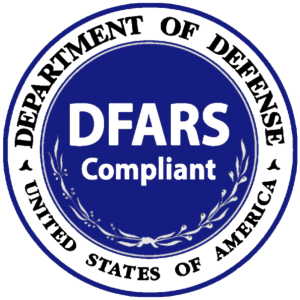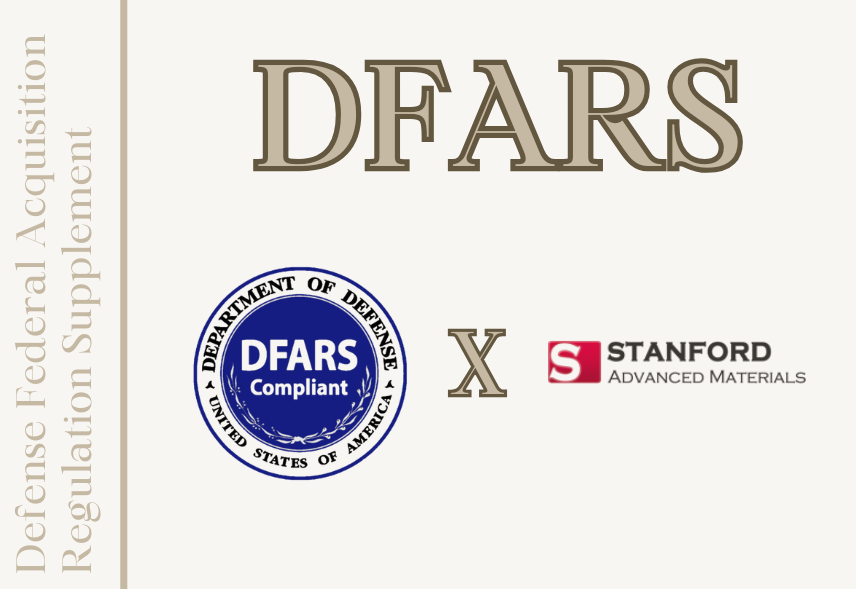If you’re supplying materials into U.S. defense contracts—directly or indirectly—DFARS compliance isn’t optional. It’s mandatory. And with rising geopolitical risk and tighter supply chain scrutiny, contractors are under growing pressure to prove their materials don’t originate from restricted sources like China.
At Stanford Advanced Materials (SAM), we specialize in providing DFARS-compliant, non-China, and U.S.-sourced materials, including sputtering targets, evaporation materials, and specialty metals. Here’s what you need to know to stay aligned with defense procurement rules.
What DFARS Is—and Why It’s Enforced
The Defense Federal Acquisition Regulation Supplement (DFARS) is an extension of the FAR (Federal Acquisition Regulation), tailored for the U.S. Department of Defense. It introduces additional rules designed to secure the defense supply chain from foreign threats and cyber risks.
Key enforcement areas include:
-
Material sourcing restrictions (e.g., DFARS 252.225-7009, 252.225-7052)
-
Cybersecurity protocols for defense data (DFARS 252.204-7012)
-
Manufacturing origin requirements (DFARS 252.225-7001)

What Materials and Products Fall Under DFARS?
Any material or product that ends up in a defense-related application could be subject to DFARS clauses. For materials suppliers, the most commonly encountered clauses include:
1. Specialty Metals – DFARS 252.225-7009
This clause restricts the acquisition of certain metals—such as titanium, nickel, cobalt, and specific grades of stainless steel—unless they are melted or produced in the U.S. or in a qualifying country. If your product contains these metals, origin traceability is non-negotiable.
Applicable to:
-
High-purity sputtering targets (Ti, Ni, Ta, Mo)
-
Vacuum deposition materials for aerospace coatings
-
Defense-grade alloys used in electronics and optics
2. Non-China Sourcing – DFARS 252.225-7052
This clause prohibits DoD contractors from acquiring “covered materials” from the People’s Republic of China. It includes not just end products but also raw material inputs and subcomponents.
Why it matters: Even if your final material is processed elsewhere, any tie to China in the supply chain is a DFARS violation.
3. Buy American – DFARS 252.225-7001
This clause mandates that certain end items be manufactured in the U.S. or in designated countries. Even for lower-tier suppliers, this affects qualification if your materials flow into a covered end item.
4. Cybersecurity – DFARS 252.204-7012
If your operations involve Controlled Unclassified Information (CUI)—such as defense technical drawings, specifications, or CAD models—you must meet NIST SP 800-171 security controls. For many suppliers, this means preparing a System Security Plan (SSP), submitting a self-assessment to SPRS, and potentially undergoing a CMMC audit.
What You’re Expected to Do
Here’s what DFARS compliance looks like in practice:
-
Validate sourcing: Ensure metals are melted in the U.S. or DFARS-approved countries. Keep mill certs and origin records.
-
Cut out restricted supply chains: No China-origin materials for restricted categories (per DFARS 252.225-7052).
-
Protect sensitive data: Meet cybersecurity requirements if you receive or handle CUI (DFARS 252.204-7012).
-
Stay audit-ready: Be prepared to document sourcing, cybersecurity, and internal processes during DoD reviews.
What SAM Offers: Materials That Pass the DFARS Test
At Stanford Advanced Materials (SAM), we help defense suppliers meet sourcing and documentation requirements without compromise:
-
Specialty metals: Titanium, tantalum, nickel, molybdenum—all sourced from DFARS-approved producers
-
Deposition materials: Sputtering targets and evaporation sources traceable to compliant melt origins
-
No China sourcing: We maintain strict exclusion of PRC-origin raw materials across all product categories
-
Full paperwork: Material certs, country-of-origin documentation, and DFARS clause alignment—ready for customer compliance teams
Whether you’re building optoelectronic coatings, IR detectors, or high-reliability sensors, we make it easier to source materials that check every DFARS box.
Final Word
DFARS isn’t a recommendation—it’s a contract gatekeeper. If you’re in the defense supply chain, you’re expected to prove where your materials come from, how your systems are secured, and that no part of your process relies on unapproved sources.
At SAM, we take that expectation seriously. That’s why our materials aren’t just high purity—they’re compliance-backed, traceable, and built for defense-grade accountability.
Contact us to request DFARS-compliant materials or technical support.





